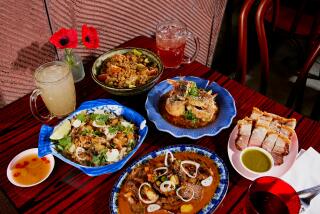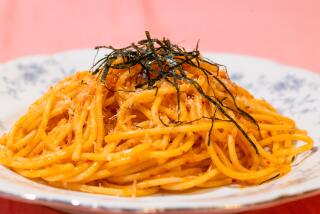Souvenir of Singapore
SINGAPORE — Frangipani trees drop perfumed blossoms at my feet as I stroll toward the entrance of the Raffles Hotel. A tourist snapping photos of the doorman wears a pith helmet called a topee, which once shaded British planters from the noonday sun. It’s night now, so the topee is as out of place as the man’s chartreuse shorts and black and white running shoes. Outside, on Beach Road, sit empty tourist buses--bas pesiaran, they’re labeled in Malay--whose passengers are now inspecting Southeast Asia’s most famous hotel.
Super-luxurious--and super-expensive--this is the new, remodeled Raffles, and it’s nothing like the hotel that once epitomized the steamy tropics.
The Long Bar, where the Singapore Sling was created in 1910, remains in name only. In the hotel’s early days the bar was located on the ground floor, a sprawling, well-worn room open to the breezes and the clash and clatter of tropical storms. Now it’s a fancy air-conditioned watering hole upstairs.
The porch-like restaurant that once looked out on the Palm Court, a large garden with a swimming pool, has also vanished. It was a pretty place, done up in frilly white wrought-iron furniture, the tables covered with dainty flowered cloths. A green-and-white striped awning kept the sun out but not the hot and humid air.
I used to breakfast there regularly. When it rained, my hands would become as wet as if I had washed but not dried them, and my whole-wheat croissant would turn to paste. I drank endless cups of coffee as an excuse to linger, reading the paper and listening to the songbirds. Each morning, the bird’s cages were brought out and hung up high so they could enjoy fresh air until the sun became too strong.
On my first trip to Asia in the ‘60s, I stayed at the Raffles. My room, which was actually a suite, cost only $13, but in those days, that was expensive. A large sitting room contained a chaise longue, couch and writing table--shades of Somerset Maugham, who always comes to mind when one talks of the Raffles. Next came the bedroom, then a capacious dressing room that opened into the bathroom. This upstairs suite overlooked the Palm Court, where fan-like traveler’s palms waved a greeting.
The Raffles lobby, quite modest in the days I first saw it, is now so glitzy that anything less than evening dress seems inappropriate. Indeed, as I sit in the lobby waiting for a table in the Tiffin Room, my eyes are drawn to a woman who speaks with a proper British accent and has such a regal bearing I think for a moment I have encountered Queen Elizabeth.
The Tiffin Room has also changed. Its ceiling fans still turn lazily, but they’re only for atmosphere. The air-conditioning is so cold I wish I had brought a shawl.
Other tourists fill the tables, most of them sipping a pink drink topped with a cherry and a pineapple wedge on a pick. This is, of course, the Singapore Sling. And if you want the world to know that you drank one at its place of origin, you can buy a Singapore Sling T-shirt. Hotel shops also sell Singapore Sling coasters, place mats, glasses and packs of premixed Slings.
On Sunday afternoons, the Tiffin Room used to offer a buffet of Nonya food, the Singaporean cuisine that blends Malay and Chinese flavors. The assortment of dishes was amazing, and it’s no wonder the buffet was called tok panjang (long table). I remember pork satay that was simmered in spiced coconut milk rather than grilled on sticks, and pulot hitam, a dessert of black sticky rice topped with salted thick coconut cream.
Now the Tiffin Room has switched to Indian cuisine, and not the Anglo-colonial curries of yesteryear. On Sunday afternoons, those curry powder-laced dishes were served in the Elizabethan Grill. There would be lamb, chicken, fish, seafood and vegetable curries and even a beef curry, which you certainly would not find in India, where the cow is venerated and roams at will.
You would heap the curries onto rice, then dress them up with the sort of fancy condiments that once made curry the rage at dinner parties. There would be roasted peanuts, diced pineapple, apple, cucumber and tomato, sliced banana and shredded coconut. More exotic local garnishes included crisp, fried ikan bilis, which is a tiny fish; shrimp chips; Indian pappadums; and mango chutney.
My favorite dessert was gula melaka, a Nonya concoction of sago (it comes from the pith of the sago palm), over which you poured palm sugar syrup and coconut milk. You could also have banana and pineapple fritters drizzled with golden syrup or fresh fruit.
Coffee would be poured from a heavy silver service, and the waiter would add the sugar and cream so you didn’t have to stir from your post-lunch lethargy. It made me feel like a real memsahib.
Aside from the weekly curry lunch, the Elizabethan Grill specialized in Continental fare. I recall lunching there on crab cocktail and Roman spring chicken that turned out to be something like chicken cacciatore. And I remember a dinner with a one-time beau, an officer on a freighter, at which we ate wiener schnitzel, drank beer and finished with crepes suzette. A dark, wood-paneled room with leaded windows, the Elizabethan Grill is now the Raffles Grill.
The Raffles Hotel has indeed changed, just as Singapore is no longer a mysterious outpost but a modern commercial city. I’m sorry that the old days are gone, but I love the Indian food in the new Tiffin Room. It’s some of the best anywhere, and I stop there regularly on my way to the subcontinent. The buffet holds so many dishes that I never manage to try them all. At dinner, when tandoori meats and seafood are added, there’s even more.
Last year, during just one lunch, I tasted lamb from Lucknow, sweet-sour fish from Orissa, mint-flavored fried chicken wings from Bombay, pomfret topped with spicy prawn balchao from Goa, spinach with eggplant from Gujarat, Peshawari-style cauliflower, lentils with bottle gourd from Bengal and south Indian fish molee.
This spring, I ran into new dishes, including fish with fresh dill, red snapper with tamarind sauce and tandoori cigale lobster, a small crustacean that is also known as slipper lobster. Along with Indian desserts such as South Indian payasam--vermicelli in sweetened milk, there was bubor chacha--a hot, sweet coconut milk-based soup that you find at most hawker centers in Singapore.
I usually skip the Continental-style cakes and tarts in favor of seasonal fruits such as fresh longans, jackfruit and the awesome cerise and white dragon fruit. This time, a side table held an entrancing pink ice cream flavored with rose and cardamom. When I became too embarrassed to return for yet another taste, the waiter brought it to me.
The chef responsible for all this is Vikrant Kapoor, who comes from Bombay but certainly knows his way around Indian regional cuisines. I love his green papaya chutney--thinly sliced papaya in a sweet-sour sauce flavored with fennel seeds. Authentic? I guess so, because I ran into the same chutney at a five-star restaurant in Calcutta.
When I questioned the Western-style salad bar set up at one side of the buffet, Kapoor responded that eating in the Tiffin Room is “a cross-cultural experience.” But most of the food is as Indian as can be, the room is beautiful and I am always sad when I can eat no more.
I know that I’ll return, though. But as I wander out the curved driveway into the balmy night, I still think longingly of the Raffles as it used to be. That I will never see again.
RED SNAPPER IN TAMARIND SAUCE
The use of curry leaves indicates that this dish is from south India, where the fragrant leaves are a common seasoning. You can buy them fresh or dried at Indian markets. Blocks of tamarind pulp are sold in Thai, Indian and Chinese markets. Indian markets may also have bottles of tamarind liquid, which may be substituted for the Tamarind Paste (use 2 tablespoons of the liquid in this recipe).
TAMARIND PASTE
1 tablespoon dried tamarind pulp
2 tablespoons water
BROWN PASTE
2 tablespoons finely chopped onion
2 teaspoons minced garlic
2 teaspoons oil
2 tablespoons cashews
Water
RED SNAPPER
2 1/2 tablespoons flour
4 1/2 teaspoons chopped garlic
1 tablespoon chopped serrano or other green chile
1 egg, beaten
3/4 pound red snapper fillets, cut in 1-inch cubes
Oil
1 teaspoon brown mustard seeds
1/3 cup chopped red onion
1/2 fresh red chile, chopped
8 curry leaves
1/8 teaspoon turmeric
2 tablespoons Tamarind Paste or bottled tamarind liquid
1/2 teaspoon tomato paste
1/2 teaspoon Brown Paste
Salt
1/2 cup chicken stock
3 to 4 tablespoons whipping cream
1 tablespoon butter
TAMARIND PASTE
Combine tamarind pulp and water and squeeze with fingers until flavor and color are extracted into thick liquid form. Discard seeds and pulp and reserve liquid.
BROWN PASTE
Fry onion and garlic in oil over medium heat until browned, 6 to 8 minutes.
Roast cashews in dry skillet about 5 minutes.
Process onion, garlic and cashews in food processor or blender, adding just enough water to form paste.
Makes more than needed for snapper; save extra for other uses.
RED SNAPPER
Combine flour, 1 1/2 teaspoons garlic, green chile and egg. Add fish cubes, turning to coat. Cover and marinate in refrigerator 30 minutes.
Heat 1 tablespoon oil over medium-high heat. Add mustard seeds and fry until they pop. Add remaining 3 teaspoons garlic and saute over medium heat until golden, 2 to 3 minutes. Add onion and saute until golden brown, 4 to 5 minutes. Add red chile, curry leaves and turmeric and saute over medium-low heat 1 minute. Add Tamarind Paste and tomato paste and simmer 4 to 5 minutes. Add Brown Paste and salt to taste and saute 4 to 5 minutes. Add stock and simmer until liquid is reduced by 1/3, about 10 minutes. Gradually add cream and butter.
Deep-fry fish in 1 1/2 to 2 inches medium-hot oil until cooked, 1 to 2 minutes. Add fish to sauce and simmer 2 to 3 minutes, being careful not to break up fish.
3 to 4 servings. Each of 4 servings:
255 calories; 266 mg sodium; 102 mg cholesterol; 17 grams fat; 8 grams carbohydrates; 18 grams protein; 0.42 gram fiber.
RAFFLES LAMB CURRY
Once served as part of the Raffles’ weekly curry tiffin, this recipe is now history. The hotel gave it to me in the ‘80s, and I put it into a cookbook, “Southeast Asian Cooking” (Fisher Books, 1992).
2 tablespoons curry powder
2 tablespoons water
2 tablespoons oil
1 tablespoon minced ginger root
3 large cloves garlic, minced
2 pounds boneless lean lamb, cut into 1-inch cubes
1 cup water
1/2 cup evaporated milk
1/4 cup canned tomato puree
1 (1-inch) piece cinnamon stick
4 green cardamom pods
4 whole cloves
1 1/2 teaspoons salt
Dash black pepper
Fresh or dried shredded coconut, optional
Raisins, optional
Toasted peanuts, optional
Chopped hard-boiled egg, optional
Diced tomato, optional
Sliced banana, optional
Blend curry powder and water to form soft paste.
Heat oil in Dutch oven over medium heat.When hot, add curry paste, ginger root and garlic and fry, stirring constantly to prevent burning, 2 minutes. Increase heat to medium-high and add meat. Cook, stirring, until meat is no longer pink, 8 to 10 minutes.
Add water, milk, tomato puree, cinnamon stick, cardamom pods, cloves, salt and pepper and bring to boil. Cover, reduce heat and simmer until meat is tender, about 45 minutes.
Place coconut, raisins, peanuts, egg, tomato and banana in individual bowls to add as desired.
6 servings. Each serving without condiments:
229 calories; 689 mg sodium; 80 mg cholesterol; 12 grams fat; 4 grams carbohydrates; 25 grams protein; 0.12 gram fiber.
FISH WITH MASALA AND FRESH DILL
Masala is a blend of typical Indian seasonings. The addition of dill is an unusual touch.
3 tablespoons oil
1 stick cinnamon
2 cloves
4 green cardamom pods
3 cloves garlic, minced
1 cup chopped onion
1 tablespoon chopped ginger root
2 serrano chiles, seeded and chopped
Salt
1 teaspoon cayenne pepper
1/2 teaspoon turmeric
1 small tomato, chopped
1/4 cup tomato juice
1 3/4 pounds red snapper fillets, cubed
1 tablespoon plus 1 teaspoon butter
2 tablespoons whipping cream
1 tablespoon chopped dill
1 tablespoon chopped mint
1 tablespoon finely chopped cilantro
1 tablespoon chopped green onion
Dash cinnamon
Dash ground cloves
Heat oil in Dutch oven over medium-high heat. When hot, add cinnamon stick, cloves and cardamom pods and cook until they begin to crackle, about 1 minute. Add garlic and cook, stirring, until golden, about 2 minutes. Add onion and stir-fry on low to medium heat until golden, 3 to 4 minutes. Add ginger root and serrano chiles and stir-fry 2 to 3 minutes. Add salt to taste, cayenne and turmeric and stir to blend. Add tomato and cook, stirring, 2 minutes. Add tomato juice and cook, stirring, 3 to 4 minutes.
Add fish pieces and stir carefully so fish pieces do not break up. Reduce heat to low and cook 4 to 5 minutes. Stir in butter and cream and cook until fish is fully cooked and opaque, 1 to 2 minutes. Stir in dill, mint, cilantro and green onion. Sprinkle with ground cinnamon and cloves.
6 servings. Each serving:
228 calories; 150 mg sodium; 53 mg cholesterol; 13 grams fat; 5 grams carbohydrates; 23 grams protein; 0.53 gram fiber.
ROSE AND CARDAMOM ICE CREAM
In India, this ice cream would be called kulfi and frozen in individual cone-shaped molds. Dried rose petals may be found at Indian and Middle Eastern markets
10 cups milk
1 1/4 cups sugar
3 tablespoons slivered blanched pistachios
1 tablespoon rose syrup
1 tablespoon rose water
1 tablespoon ground dried rose petals, optional
2 teaspoons ground cardamom
Bring milk to boil in large saucepan over medium-high heat. Reduce heat and simmer, stirring occasionally, until reduced to 4 cups, about 1 1/2 hours.
Strain, forcing any solid cream through sieve. Add sugar, pistachios, rose syrup, rose water, rose petals and cardamom and stir until sugar is dissolved. Let cool.
Freeze in individual ice cream molds or in ice cream maker according to manufacturer’s instructions.
Makes 1 quart. Each 1/2-cup serving:
292 calories; 153 mg sodium; 23 mg cholesterol; 7 grams fat; 47 grams carbohydrates; 11 grams protein; 0.11 gram fiber.
HOT AND SPICY OKRA
Tasters in The Times Test Kitchen suggest serving the okra with a squeeze of lime and plain yogurt on the side. Chat masala, a spice blend with the pungent aroma of black salt, and amchur, powdered dried green mango, can be purchased in Indian markets.
1 pound okra
Oil
1 tablespoon fennel seeds
1 teaspoon cumin seeds
1 onion, chopped
1 (1-inch) piece ginger root, chopped
2 serrano chiles, chopped
1 teaspoon cayenne pepper
1 teaspoon chat masala
1 teaspoon amchur
1/2 teaspoon turmeric
1/2 teaspoon salt
Cut okra into 1/2-inch pieces. Heat 2 tablespoons oil in skillet over medium-high heat. When hot, add okra and fry until softened, 4 to 5 minutes. Remove from skillet and set aside.
Heat 1 1/2 tablespoons oil in same skillet over medium heat. Add fennel and cumin seeds and fry until seeds crackle, 1 minute. Add onion, ginger and chiles and saute 3 minutes. Add cayenne, chat masala, amchur, turmeric and salt and cook, stirring, 2 minutes. Add okra and cook, stirring, 5 minutes.
4 servings. Each serving:
180 calories; 309 mg sodium; 0 cholesterol; 13 grams fat; 15 grams carbohydrates; 4 grams protein; 1.88 grams fiber.
Kotobuki plates on cover and this page are from Bristol Kitchens, So. Pasadena.
More to Read
Sign up for The Wild
We’ll help you find the best places to hike, bike and run, as well as the perfect silent spots for meditation and yoga.
You may occasionally receive promotional content from the Los Angeles Times.






